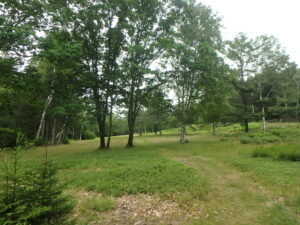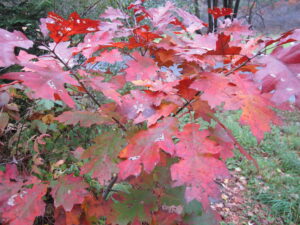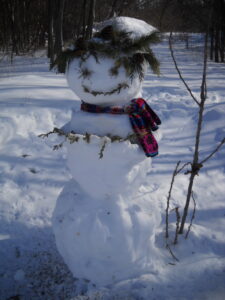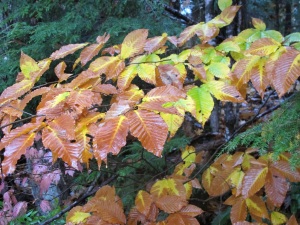Winter Thoughts about Having a Great Garden
This is a good time for all of us to stop and reflect on how we garden. Are we creating lovely-looking spaces, but failing to support pollinators, birds and wildlife? What about the environment? Can we do more? If so, how can we improve? Here are a few of my thoughts.
First, I would recommend that native plants dominate our gardens. I’d say 80% of our plants (or more) should be native, especially trees. Why? Because they do the best, by far, of supporting wildlife – feeding birds and providing food and shelter for animals. Oaks, the best tree of all for wildlife, support nearly 1,000 species of butterflies and moths. But many species of landscape trees and shrubs are from China or Japan, and many only support a handful of species. All plants are not created equal.
I think we all should avoid chemicals in the garden – and not just the vegetable garden. Rachel Carson taught the world that DDT, a powerful insecticide widely used in the 1950’s, was killing off our eagles. But all chemicals used in the garden disrupt natural growth processes – and can adversely affect us, too. Even something as seemingly bland as 10-10-10 fertilizer is only 30% fertilizer – the makeup of the rest is deemed “proprietary information”. So we don’t know what chemicals are used in it. And the salts in fertilizer are lethal to many microorganisms.

Oaks and birches growing in a meadow can feed pollinators and help birds and can be a substitute for a lawn
Even pesticides that are derived from plants would be banned, if I ran the world. Yes, they are listed for use by organic growers, but many of them are non-specific killers. Both rotenone and pyrethrins are “organic”, but very toxic to bees, others to fish and toads. I guess I would make you pass a test about the pro and cons of any pesticide before you could buy it! Go to https://www.thespruce.com/
Think about the size of your lawn. Does it need to be so big? Could you plant some native trees or shrubs? Once established, trees are very little work. They provide shade and cool the air in summer, and fix carbon in the soil – carbon that otherwise would be contributing to global warming.
The Under Appreciated Yellows and Browns of Fall
I took a walk this week along a country road and was delighted by the colors of the fall leaves. The reds –maples, largely – have fallen, but the yellows and browns are still on some trees and lovely. And once you develop an appetite for the less flashy leaves, you may want to plant a tree that will do”the late show” in years to come.
The oaks and beeches are particularly nice right now. Oaks hold onto to their leaves much later than the maples, developing a more subtle coloration: browns mixed with russet or carmine or maroon. Perhaps burnt umber. Worldwide there are some 500 species of oaks, but here in the wild forest, just a few. Seven are listed by Cooperative Extension as native to New Hampshire, but only two are common: northern red oak (Quercus rubra) and white oak (Q. alba). Additionally there are many pin oaks (Q. palustris) that have been introduced and used as good tough street trees. In fact, I’ve read that pin oak is the most commonly planted tree in America.
Oaks generally fall into two categories. Red oaks have leaves with pointed tips on their lobes; those with rounded leaf edges without any sharp points are considered white oaks. Red oaks produce acorns that only germinate after a cold period of 30 to 60 days in a process called stratification, while white oaks can germinate right away. The Washington oak, a white oak in Princeton, NJ, is over 275 years old.
Oaks, and nut trees in general, have tap roots that go down deep in the soil. White oaks really are best started by planting acorns, or getting a small tree at a nursery. By the time a white oak has a trunk that is two and a half inches in diameter, it’s too big to move. Pin oaks, one of the red oaks, have fibrous roots that are near the soil surface and can be planted or moved more easily.
Acorns have always fascinated little children (and me). They are shiny, smooth and shapely. They feel good when in your pocket. They have a little hat that stays on while on the tree, but falls off once ready to be planted. Acorns that are fertile always lose their caps, so don’t plant one wearing a cap.
Beeches (Fagus grandifolia) are also wonderful at this time of year. Like the oaks, beeches hang on to their leaves – some of the young trees keep their leaves until May, when new leaves push them off the branches. And although the fall color is yellow, never red, some will display stripes of green in leaves while the yellows develop. Eventually, they all turn brown and produce a nice sound as the dry leaves are teased by winter breezes.
Beeches have smooth gray bark that is splendid in winter. But many beeches suffer from a fungal disease which mars the bark and kills off older specimens. The trees are attacked by a scale insect that damages the bark, allowing a fungal disease called Nectria to infect the trees. According to a US Forest Service pamphlet, the scale insect arrived from Europe in the 1890’s and, like many foreign pests, had few enemies here in North America (it first appeared in Nova Scotia). These is no easy remedy if your beech trees are infected.
Another great tree for yellow leaves in the fall is the bottle brush buckeye (Aeseculus parviflora), a member of the horsechestnut family. I just planted one this fall because it has great spring flowers, will blossom nicely in the shade or part shade, and tolerates moist soil. I had just the right spot. The brilliant yellow fall leaves were a bonus.
My hybrid ‘Merrill’ magnolia has great yellow fall color, too. And if you get up close to the tree, you can see that it is loaded with small, bright red berries nestled in their pods. The buds for next year’s flowers are on the tree, too, and will become more noticeable once the leaves and seeds have dropped. The buds look like pussywillow buds on steroids.
At this time of year the weather tends to be a bit gloomy. Rainy cold weather is not much fun, and the sun sets by supper time. So what can a gardener do? Plant some acorns. My friend Joe Monninger of Plymouth, NH went out one fall about 10 years ago and planted a bunch of acorns. I called him this week to see how they did.
Ten years later- despite squirrels, lawn mowers and weed whackers – four of Joe’s acorns have grown to stand waist high. Not bad. He hadn’t done anything to improve the soil, he hadn’t fenced them to keep away deer. He just poked some holes in the ground and planted acorns. Even if he planted 25, he has four nice trees – and that’s not a bad return on his labor, if you ask me. If you plant some acorns, put one of those little white plant labels near each one so you will be careful to avoid stepping on them when young – or mowing them down. And in 300 years they might still be alive and producing acorns.
I believe in enjoying what I have. Take time, I say, to slow down and really look at the subtleties of nature and the garden. Red is not the only good fall color.
Henry is the author of 5 books. His web site is www.Gardening-Guy.com. You may send questions to him at henry.homeyer@comcast.net.






